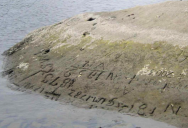Why Hunger Stones Are Terrifying People In A Drought-Ravaged Europe
Recent heatwaves and ensuing droughts in Europe are not exactly causing people to be comfortable – but the re-emergence of “hunger stones” due to low water levels definitely are not helping matters at all.
Hunger stones are a hydrological monument found in some Central Europe rivers and are revealed when water levels drop. They date back to the 15th-19th centuries, purposefully embedded to warn future people of hard times ahead.

Image Credit: Dr. Bernd Gross
Some also bear watermarks with dates of previous droughts, which is delicious primary evidence for those interested in historical weather patterns.
Researchers from Masaryk University recently studied one of the most famous hunger stones in Czech history.
“It expressed that drought had brought a bad harvest, lack of food, high prices, and hunger for poor people. Before 1900, the following droughts are commemorated on the stone: 1417, 1616, 1707, 1746, 1790, 1800, 1811, 1830, 1842, 1868, 1892, and 1893.”

Image Credit: Public Domain
The stone lies in the Elbe River near the German border, and bears the inscription “if you see me, weep.”
Not to be dramatic or anything.
Europe’s current drought is the worst in over 500 years, and combined with record-breaking heatwaves, people are understandably already on high-alert.
That said, the hunger stones have emerged before, most recently in 2018.

Image Credit: Derzsi Elekes Andor
As things regarding the worldwide climate continue to deteriorate, we’re likely to see them again, and sooner rather than later.
Scientists believe things will get significantly worse, in fact, with shifting wind and weather patterns making it more likely that air pressure systems will hang around longer, creating even lengthier droughts.

Sign up to get our BEST stories of the week straight to your inbox.




